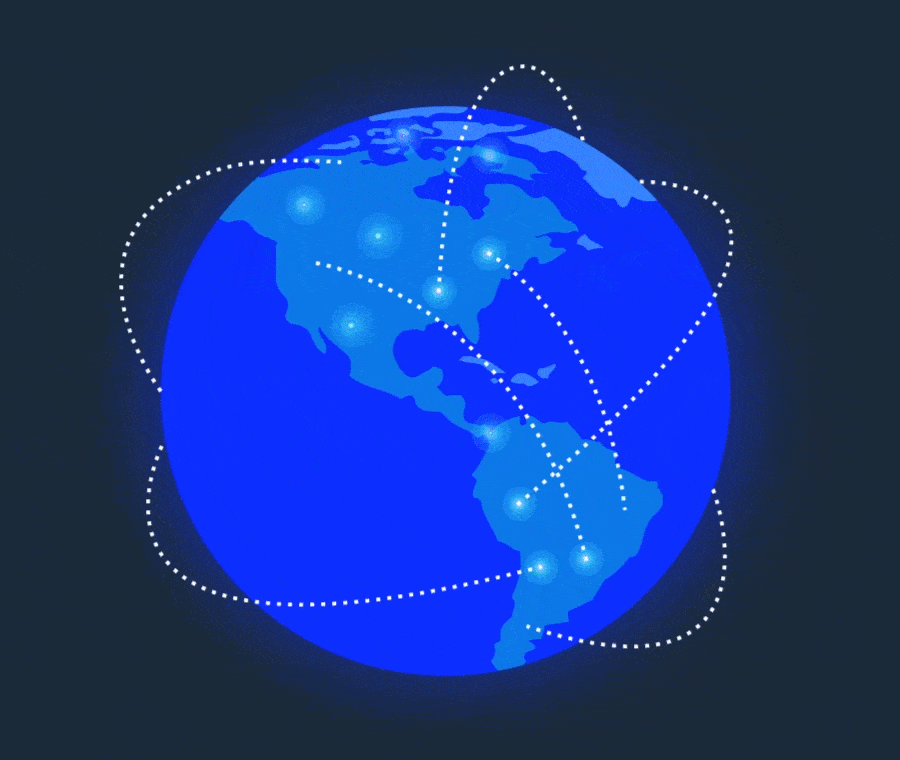THE DIGITAL FUTURE OF CROSS-BORDER LOGISTICS
E-commerce is global commerce, creating real opportunities for businesses to tap new markets around the world. But with e-commerce growth outpacing logistics infrastructure, cross-border shipping remains fraught with customs delays, regulatory changes and fragmented tracking systems which adds in costs, delay and unhappy customers. Finding solutions to these barriers could unlock real competitive advantage.


‘There are challenges with cross-border trade and transportation but there are also huge opportunities,’ says Felix Blaich, Director of International Postal Relations at Deutsche Post. ‘It’s a fast growing market, faster than the domestic market, so there’s huge potential here if we can address these challenges.’
Technology will be key to unplug bottlenecks and keep the wheels of trade moving no matter what the future holds, be it political upheaval, regulatory changes or even war. In Ukraine, for example, where there has been more than three years of war, with frontline regions under almost constant anti-air raid alerts and infrastructure badly damaged, including roads, post offices and fleets, not to mention the human casualties, the post still gets through.

We have come to understand that war is not an excuse, it’s just an opportunity to do your job better.
Oleksandr Holosa
Deputy Director of International Operations,
Ukraine Post

‘We have come to understand that war is not an excuse,’ says Oleksandr Holosa, Deputy Director of International Operations at Ukraine Post. ‘It’s just an opportunity to do your job better to support your people, your country and do everything you can to be a better member of society.’
Things that have contributed to this effort include a network of 1,900 mobile post offices, include more than 30 in frontline areas, which deliver not just post and parcels but also provide financial services, so that people can collect their pensions or pay utility bills, along with pharmacy services.
The company is also installing modular container-style branches, which are completely self-sufficient with solid fuel boilers, generators and Starlink connection to build more resilience into the network. When a post office in Donetsk was hit by missiles, says Holosa, it was quickly replaced by a modular container and back in service within five days. A portfolio of 1,700 generators, 1,200 Starlinks, power banks and charging and almost 4,000 off-grid three-in-one devices have also bolstered resilience.
The company has also invested in automation, with 24 sorting centres now completely equipped with autonomous sorting lines, along with digitalisation of customs.
‘We have completely paperless customs clearance, and 97% of the parcels we touch only once,’ says Oleksandr Holosa, adding that 70% of international items get customs clearance within three hours.
These are statistics that any operator would be proud to claim but are particularly impressive given the circumstances. Carriers across Europe face their own obstacles to smooth and efficient cross border logistics, with a fragmented regulatory and fiscal regimes adding complexity to stretched logistics infrastructure. And carriers are bracing for further challenges, with Christelle Defaye Geneste, Director of European and Customs Affairs at La Poste, saying new legislation under discussion seems to have the aim to further complicate the process.


How do we reconcile customer demand for cross-border efficiency with the politics and regulations? It’s important to have regulation that facilitates rather than puts obstacles to trade.
Christelle Defaye Geneste
Director of European and Customs Affairs,
La Poste
‘How do we reconcile customer demand for cross border efficiency with the politics and regulations?’ she asked. ‘It’s important to have regulation that facilitates rather than puts obstacles to trade.’
Partnerships are critical to cross-border trade, with many different parties involved in moving goods across multiple borders. While there are times when it makes sense to be carrier agnostic, Elke Segers, Executive Vice President, Transformation, Strategy and Performance Cross-Border, bpost, believes there’s real value to embedding long-term partnerships.
‘When it’s quality and service you’re striving for, it’s not worth switching provider for five cents,’ says Segers. ‘It’s commercial relationship but you need to build it into a partnership.’
Partnerships can also help companies tap into the innovation that will be key to improving efficiency and services levels across the supply chain. ‘Postal companies are not very innovative because our size, history and legal obligations have tended to restrict innovation,’ says Felix Blaich, Director of International Postal Relations at Deutsche Post. ‘Innovation is driven by start-ups and researchers, so partnership with these companies is essential, especially for last mile delivery solutions, because we are not good at doing this ourselves.’
Innovation is also important when it comes to removing friction from customs clearance, which is a pain point for all parties. With the VAT changes and abolition of Low Value Consignment Relief in 2021, bpost decided to digitalise inbound clearance and for those items for which it has all the data, customers are invited to pay all taxes and duties in an app, with additional questions sent for those shipments that are missing the correct data.
Here’s Elke Segers, Executive Vice President, Transformation, Strategy and Performance Cross-Border, bpost to tell us more about how bpost is leveraging digitalisation to optimise cross-border flow.
‘There can be huge liabilities for items that come from specific countries if there are under-valuations or incorrect HS codes, so we are using AI and machine learning to make sure it’s correct,’ says Elke Segers of bpost. ‘We’re also using AI to identify whether gifts that enter are really gifts, because you can find some of them are really B2C parcels.’

You do not need to 100% automate almost every single site because it’s not always the most profitable.
Elke Segers
Executive Vice President, Transformation, Strategy and Performance Cross-Border,
bpost

Automation is clearly making an impact in fulfilment centres, although this is not universal. ‘We have some fulfilment centres that are fully automated but at other sites we have bits of automation but the rest is manual, because sometimes that’s the most efficient solution,’ says Elke Segers of bpost. ‘You do not need to 100% automate almost every single site because it’s not always the most profitable.’
Customers also still value the human touch, says Felix Blaich, Director of International Postal Relations at Deutsche Post. ‘There’s no limit to automation when it comes to internal processes given high labour costs in Europe but it’s different when it comes to human interactions,’ he adds.
For now, humans and machines are working together to develop ever more efficient and streamlined supply chains to keep trade flowing, whatever the future may hold.
Stay in the loop with Leaders in Logistics
Subscribe to our newsletter to receive news,
updates and special offers.


